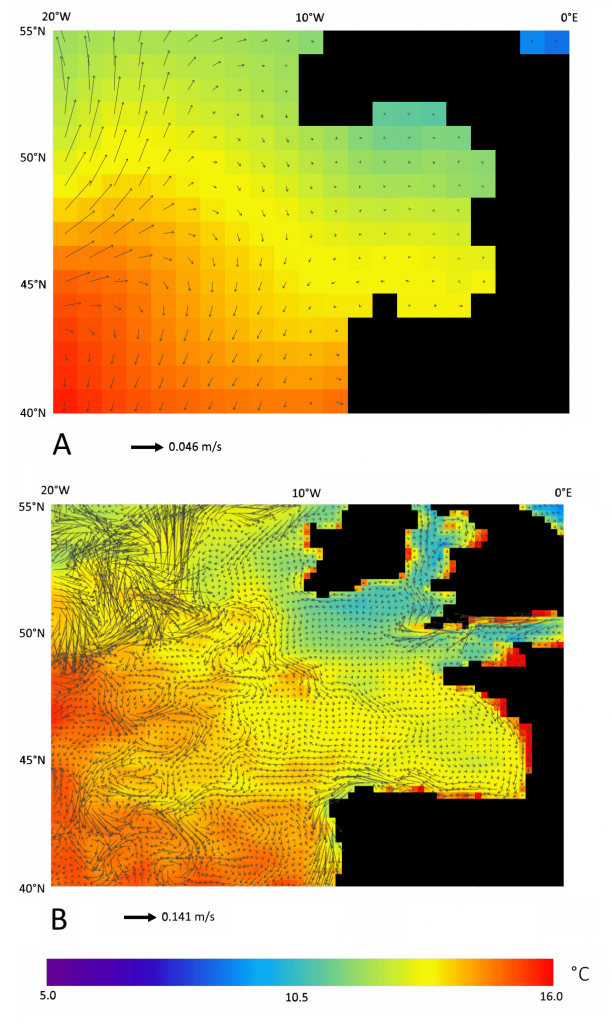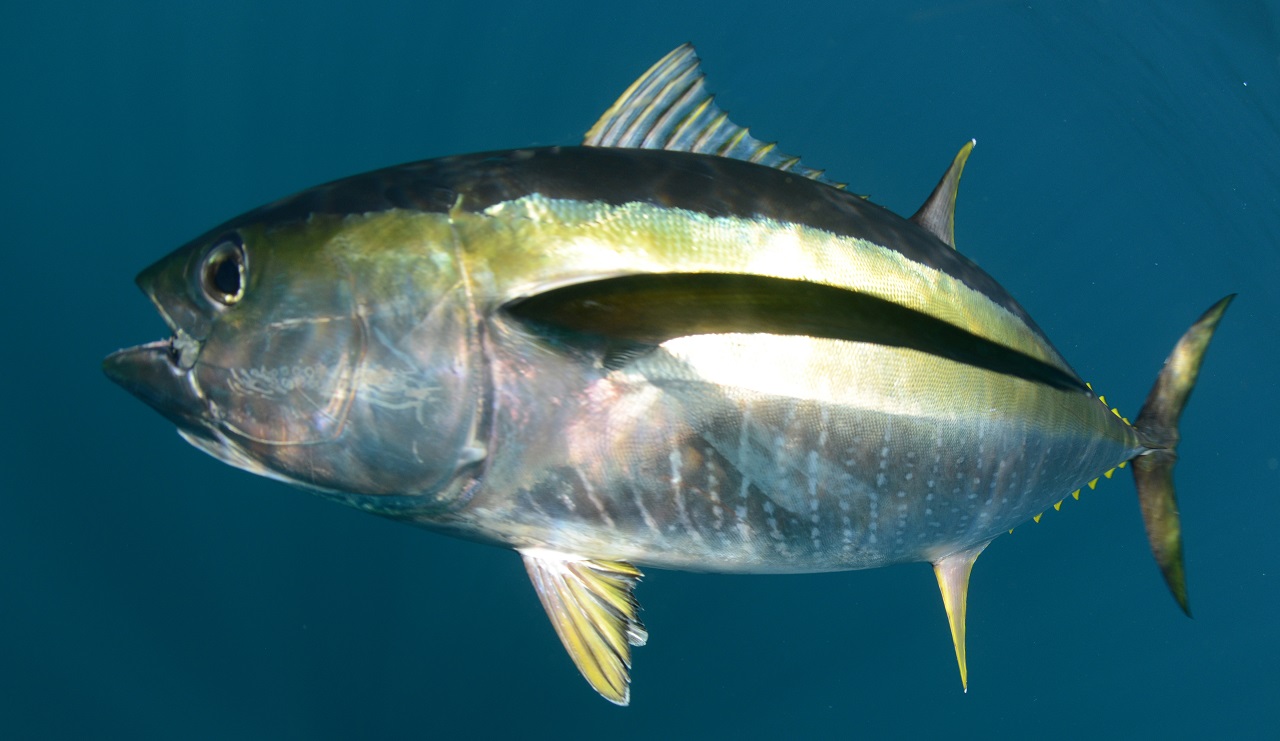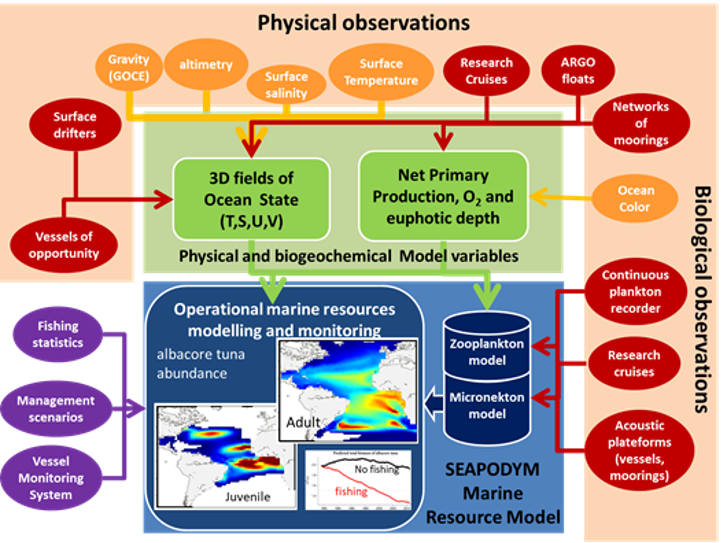
Optimising and Enhancing the Integrated Atlantic Ocean Observing Systems
AtlantOs, WP8: Societal benefits from observing / information systems
The objective of AtlantOS is to achieve a sustainable, efficient, and fit for-purpose Integrated Atlantic Ocean Observing System (IAOOS). AtlantOS contributes to blue growth by merging new information needs relevant to key sectors such as transport, tourism, fisheries, marine biotech, resource extraction and energy with existing requirements.
Work Package 8 (Societal benefits from observing/information systems) delivers a products addressing societal concerns in European Member States. With SEAPODYM, we developed an Operational forecast system for Atlantic albacore tuna to support population and fisheries management.
Fisheries regulations, such as those established by the European Commission, need to rely on the best available scientific advice to ensure that fish stock exploitation levels remain sustainable over the long term. Fish population dynamic models are essential tools for estimating fishing impacts and providing key indicators of harvesting.
Progress in fish population modelling integrating environmental variables derived from Earth Observation and Operational Oceanography COPERNICUS CMEMS enabled us to develop a near real-time forecast of a key tuna stock in the Atlantic Ocean.
AtlantOS T8.7 provides a model for albacore tuna to simulate in near real-time the change in abundance over time and space of this species by life stage (larvae, juveniles, adults).
The first step was to rebuild the history of Atlantic Albacore tuna under the combined effects of fishing and environmental variability based on historical catch data collected by ICCAT and ocean variables available from satellite observation and ocean models. Then the results were transferred into an operational chain of production regularly updated with CMEMS products and showing variability due to fishing and the environment. We followed an approach similar to the one we developed for the project INDESO for tropical tuna species.
GOOS Essential Ocean Variables (EOVs) are used to drive the albacore tuna model for the historical reconstruction and the weekly bulletin. They include primary production derived from satellite ocean color and surface solar radiation, and ocean temperature and currents from operational models assimilating satellite (sea surface temperature, sea surface height) and in situ data (temperature, salinity and currents) provided by moorings and profilers. Other essential ocean variables are the dissolved oxygen concentration currently provided from climatology (i.e. monthly average) and the zooplankton (prey of tuna larvae) and micronekton biomass (prey of juvenile and adult tuna) that are simulated from the same ocean variables. Finally, the fishing impact data used was provided by the International Commission for the Conservation of Atlantic Tunas (ICCAT).
SEAPODYM simulates the change in abundance over time and space of Atlantic albacore by age class from larvae to oldest adults under the influence of environmental variables that drive the movement between feeding and spawning grounds, the success of spawning and the mortality of fish. Multiple international fisheries are characterized (fishing gear, strategy, size selectivity, etc.) and their catches are included to measure fishing impact. As in the standard fish stock assessment modelling approach, a statistical method is used to calibrate the model parameters and thus provide estimates of fish abundance by age class based on observations (catch, fishing effort and size frequencies of catch).
The simulations of albacore history enable us to analyse the impact of current fishing levels, and the near real-time outputs should help management and monitoring decisions and the detection of illegal fishing. They should also assist the fishing industry to plan their operations in order to maximise cost efficiency, decreasing fuel consumption and allowing profit at lower level of catch, thus providing favorable conditions to release fishing pressure on the exploited stock.
- The model parameters are estimated with a maximum likelihood estimation approach that minimises the differences between the observed and predicted fishery values from multiple fisheries. Due to intense computational needs for parameter optimisation, this phase uses a coarse resolution (2° x month).
- Data used are georeferenced catch, fishing effort, catch per unit of effort (CPUE) and the size frequencies of catch. Catch by age are predicted based on the observed fishing effort and a catchability coefficient and a selectivity function characterising the fishing fleet. Catch is also used to account for fishing mortality.
- Density of larvae recruited in the first cohort results from density od adult mature fish and the favorability of the spawning habitat index combining temperature preference and coincidence of spawning with presence or absence of predators (micronekton) and food (zooplankton) for larvae.
- After the spawning, different life stages are considered: larvae, juveniles, immature and mature adults. At larvae and juvenile phases, fish drift with currents; later on they become autonomous, whereby in addition to the currents velocities their movement has additional component linked to their size and the habitat value. The feeding habitat is based on the accessibility of tuna to the groups of micronektonic forage.
- From the pre-defined age at first maturity fish start spawning and their displacements are controlled by a seasonal switch between feeding and spawning habitats, effective outside of the equatorial region where changes in the day length are marked enough and above a threshold value.

Monthly maps showing the predicted average biomass of adult mature albacore and their feeding migrations in Atlantic ocean distributions over 2001-2010. The circles show the catches by fisheries targeting mature albacore.

- The operational chain of production has been implemented to provide near real time of mid-trophic functional groups and then tuna density distributions.
- Before running the tuna model, a downscaling approach is needed to adapt the parameterization achieved at coarse resolution to the new environmental forcing at higher resolution.
- Downscaling ensures that spatial distribution and biomass will not differ too greatly from the ones estimated with Maximum Likelihood estimation.
- This task is ongoing.
- The operational configuration at higher resolution provides better and more accurate outputs in key zones, such as in North Atlantic areas where the fishing effort by the European fleet is high and concentrated in a region not well represented at coarse resolution.

North Atlantic South Atlantic
- Two simulations are run in parallel with and without fishing impact. The difference gives the fishing impact on the stock while environmental variability is illustrated from unfished stock simulation.
- Albacore model outputs are aggregated by life stage and presented with density maps, and time series of key indicators, including total biomass of adult (spawning biomass), young recruits, and biomass reduction due to fishing.
- Given that fishing data are not yet collected in near real-time, an average (last 5 years) of fishing effort and catch was used to avoid a drift of the model estimates in the absence of fishing.
- In the future, such a model could be directly plugged into to the catch and fishing efforts collected in near real-time using Vessel Monitoring Systems (VMS) and Electronic Reporting Systems (ERS).

Impact of fishing on Atlantic albacore. Map showing the reduction of biomass in adult (spawning) albacore for the year 2010. The color scale highlights the reduction of biomass (kg km-2) in the map and the iso-contours display the percentage decline.
Albacore Tuna

Operational results
Atlantic Albacore
Albacore tuna (Thunnus alalunga) is a relatively long-living (>13 yr) species inhabiting tropical and subtropical waters (all oceans). Adult fish can grow to 40 kg (120 cm). For management purposes distinct stocks are considered in the Mediterranean Sea, the north and the south Atlantic with limited interactions between them. They mature at age ~4.5 years. Mature fish spawn in warm waters and juveniles seem to spend the winter in subtropical areas.
For the last 60 years, albacore tuna has been exploited in the Atlantic by various fishing gears. In the North Atlantic, total reported landings increased to a peak ~60,000t in the early 1960s, declining afterwards, largely due to a reduction of fishing effort. The subsurface longline fishery catch (Chinese Taipei, Korea and Japan) has decreased since 1986 due to a shift toward tropical tuna for the sashimi market. European fisheries (Spain, France, Ireland and Portugal) are surface fisheries targeting mainly immature and sub-adult fish in the Bay of Biscay and the Celtic Sea in summer and autumn, and also around Madeira and the Azores. Caribbean Countries contribute to the remaining catch (~2%), mostly by longlining. The catch in the last five years was stable at ~ 27,000 mt. The preliminary total reported catch in 2017 was just above the TAC of 28,000 mt.
In the South Atlantic, albacore fisheries are dominated by the surface baitboat fleets from South Africa and Namibia, and the longline fleets from Brazil and Chinese Taipei. The overall catch of the Southern Atlantic albacore fisheries oscillated near ~24,000 mt between 2006 and 2012. This was followed by a large drop to less than 14,000 t (more than 40% reduction) since 2014 (13,806 mt in 2017).

Geographic distribution (5°x5°) of albacore mean annual catch by major gears for 1987-2014 before scaling to nominal catch level (based on ICCAT database). Longline in green and surface gears (bait boats and trolling boats) in blue.
Ocean in situ (red) and satellite (orange) data are the primary information to feed physical and biogeochemical models delivering the necessary variables for the Operational forecast system for Atlantic albacore tuna (T= temperature; S = Salinity; U and V are east-west and north-south components of currents).

